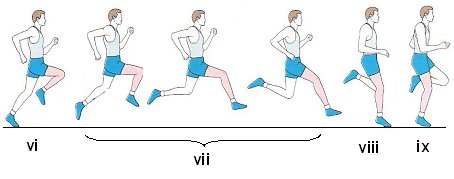By breaking sprinting technique into its component parts you can focus on and improve specific phases of the action. Good sprinting technique has some of the following characteristics (1):
START PHASE
i) Bodyweight evenly distributed over four contact points in the start position (i.e. hands and knees). Front knee angle is ~90o, rear knee angle ~100-130o.
ii) Explosive push off with both legs. Front leg extends remaining in contact with the ground while back leg swings forward. Extended front leg and trunk form a straight line.
iii) Arms swing opposite to legs, elbows flex to ~90o and fists swing towards forehead.

ACCLERATION PHASE
iv) After first two strides, foot touches down in front of center of gravity.
v) Forward body lean begins to decrease until normal sprinting position is reached after about 22 yards (20 meters). Head is relaxed, eyes focused straight ahead.

MAXIMUM SPEED PHASE
vi) Push-off angle from ground is ~50-55o. Trunk is almost erect with ~5o forward lean.
vii) (Midflight) Push-off leg folds tightly towards buttocks in a relaxed heeling motion. Front leg thrusts forward and upward at maximum speed (~44mph in elite sprinters). When front thigh reaches maximum possible knee lift, lower leg swings forward in a relaxed movement.
viii) Foot meets ground with ankle slightly extended (plantar flexion) directly under center of gravity. Bodyweight is balanced so that only the ball of the foot touches the ground.
ix) Shoulders remain steady, elbows flexed at ~90o, kept close to body throughout all phases. Hands swing forward and up above shoulder height, down and past hips. Arms and hands should have an aggressive hammering action. Head aligns naturally with trunk and shoulders and facial/neck muscles are relaxed by keeping the mouth slightly open.

Sprinting Technique Program
These sprinting technique drills can be performed in this order or alternatively focus on just 3-4 drills. There is no need to perform multiple sets and repetitions.
Raise Knees: 10 meters – jog – 10 meters – rest
Sprint 10 meters concentrating on raising knees as higher than normal. Jog for 10 meters and then sprint for 10 meters and rest.
Fast Knee Pick Ups: 10 meters – jog – 10 meters – rest
Jogging on the spot raise your knees to waist height while emphasising arm action. Move forward 10 meters with this action concentrating on the number of ground contacts rather than how fast you cover the distance. Try to get as many ground contacts as possible.
Flicks: 10 meters – jog – 10 meters – rest
While sprinting over 10 meters concentrate on flicking your heels up to touch your butt.
Leg Speed: 60 meters
This is a normal sprint over 60 meters except all of your focus should be on your legs. Try to gauge the optimum leg speed for you by taking different stride lengths to see which yields the best results.
Skipping: 40 meters
High Hops: 3 x 40 meters
Bound from one foot to the other. The action is similar to skipping except your are trying to gain as much height as possible and stay in the air for as long as possible. Remember to recover fully between attempts.
Elbow Drive: 40 meters
Sprint for 40 meters concentrating on driving your elbow in a straight line. Keep your elbows flexed at right angles while keeping your arms relaxed.
References for sprinting technique
1) Baechle TR and Earle RW. 2000 Essentials of Strength Training and Conditioning: 2nd Edition. Champaign, IL: Human Kinetics

Jacky has a degree in Sports Science and is a Certified Sports and Conditioning Coach. He has also worked with clients around the world as a personal trainer.
He has been fortunate enough to work with a wide range of people from very different ends of the fitness spectrum. Through promoting positive health changes with diet and exercise, he has helped patients recover from aging-related and other otherwise debilitating diseases.
He spends most of his time these days writing fitness-related content of some form or another. He still likes to work with people on a one-to-one basis – he just doesn’t get up at 5am to see clients anymore.